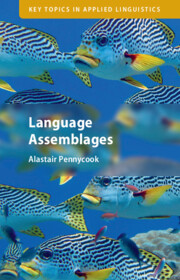Book contents
- Language Assemblages
- Key Topics in Applied Linguistics
- Language Assemblages
- Copyright page
- Contents
- Acknowledgements
- 1 Why Language Assemblages?
- 2 Language, Knowledge, Myths and Being
- 3 Structures and Practices
- 4 Linguistic, Semiotic and Sociomaterial Assemblages
- 5 Other Language Ontologies
- 6 Applied Linguistics as Practical Assemblage
- Suggested readings
- Glossary
- References
- Index
5 - Other Language Ontologies
Published online by Cambridge University Press: 20 June 2024
- Language Assemblages
- Key Topics in Applied Linguistics
- Language Assemblages
- Copyright page
- Contents
- Acknowledgements
- 1 Why Language Assemblages?
- 2 Language, Knowledge, Myths and Being
- 3 Structures and Practices
- 4 Linguistic, Semiotic and Sociomaterial Assemblages
- 5 Other Language Ontologies
- 6 Applied Linguistics as Practical Assemblage
- Suggested readings
- Glossary
- References
- Index
Summary
Taking seriously other ways that languages can be understood is of significance for both practical and political reasons. If language revival or other applied projects need practical theories of language, they need to be drawn from concerned communities rather than imported from elsewhere. For many Indigenous people, language is deeply connected to land, or what is commonly known as Country in Australia, which can include not only earth, dwellings and place but also water, animals, wind and other beings. Language within these ways of thinking is not connected primarily to people but to land or Country. It is because these ways of thinking about language are so different from a consideration of language as structure, as object, as separate from people and the world, that many language revival projects have struggled. As long as Indigenous languages are thought of in terms of non-Indigenous ontologies, there will always be at best misunderstanding. On these grounds, Indigenous language activists have called for local control of language reclamation projects and the need to decolonize what is meant by language.
- Type
- Chapter
- Information
- Language Assemblages , pp. 109 - 135Publisher: Cambridge University PressPrint publication year: 2024

